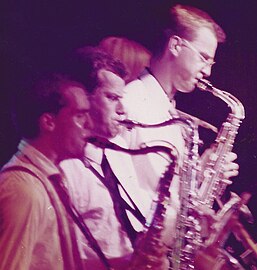Zatopek (band)
| Zatopek | |
|---|---|
 Zatopeks saxophone with Stephan, Schwietzke, Düwel (from left to right) |
|
| General information | |
| Genre (s) | Punk jazz |
| founding | 1980 |
| resolution | 1983 |
| Last occupation | |
singing |
Dorothee Gercke |
Trumpet, flugelhorn |
Sven Regener |
Alto saxophone |
Matthias Düwel |
Tenor saxophone |
Stephan Schwietzke |
Keyboards, tenor saxophone |
Peter Friedrich Stephan |
guitar |
Jürgen Mann |
bass |
Uwe Arens |
Percussion |
Borries from the bush |
Drums |
Jon Stockemann |
Zatopek was a nine-member Berlin band that is assigned to the Neue Deutsche Welle , but played a strongly rhythmic mixture of punk and jazz . It was named after the Czech long-distance runner Emil Zátopek , who was called the "locomotive" because of his tireless and rhythmic running style.
Foundation and success
The band's forerunner project began in autumn 1979 in a practice cellar in the Kreuzberg industrial estate Urbanstraße 64 with the line-up Matthias Heisig (vocals), Jürgen Mann (guitar), Gerd Möller (saxophone, Bontempi organ), Reimund Schlie (drums) and Peter Schütz ( Bass). Their band name was inspired by a documentary about Emil Zátopek, the Czech long-distance runner. Zatopek's first appearance took place together with other groups in the Urbanstrasse practice cellar on December 6, 1980. Uwe Arens now played bass and the singer was Barbara Klöwer, who from 1983 appeared as a clown and chanteuse under the name Charla Drops.
The group around Jürgen Mann and Uwe Arens experimented with guitars, Bontempi organs and cheap electronics, inspired by the New York New Wave scene. This happened to Peter Friedrich Stephan and Borries von dem Bussche after their return from the Creative Music Studio in Woodstock, NY / USA. Here they had studied with jazz greats and experienced New York punk jazz ( The Lounge Lizards , James Chance, James Blood Ulmer ). Stephan Schwietzke (also with the band MDK ), the painter Matthias Düwel, his girlfriend Dorothee Gercke and Jon Stöckemann joined them.
After a year of rehearsal, the band performed with this line-up on May 19, 1982 in Monika Döring's sold-out Berlin Music Hall . Thereupon mediation as the opening act for two Defunkt concerts with live broadcast in the Sender Freies Berlin . After the third appearance, a record deal with Polydor (producer Ekki Skull).
Further stations: Feature by Volker Panzer in the ZDF aspects magazine, title of the magazine TIP (18/1982), live concert on Bayerischer Rundfunk (“Zündfunk” on December 5, 1982) together with Family 5 , tour of Germany in spring 1983. Then productions with the American vocalist Shelley Hirsch , which was not published.
Dissolution and follow-up projects
In 1983 the group split up into various other bands and projects. Sven Regener : first founding the band “Neue Liebe”, then Element of Crime , Peter Friedrich Stephan : founding the MINT band (with Rüdiger Klose and Emilio Winschetti from Mythen in Tüten , later also Uwe Bauer, Ex- Fehlfarben ), as well as New German Design at Hans Roericht at the UdK Berlin , Dorothee Gerke: further teacher for voice training, Matthias Düwel: freelance artist in the USA, Jon Stöckemann: musician a. a. with Caspar Brötzmann Massaker, then as Techno-DJ Jonzon , Stephan Schwietzke: manager, Uwe Arens: photographer, Borries von dem Bussche first with the “Spacecowboys”, today with “Barry Black and the White Temptations” and “Too far gone”.
Reviews
"Modern folk music for dancing wildly, (...) the surprise of the past concert season".
"(...) and not only achieved full houses (small halls and large clubs), but an almost unanimous positive response from the public and the press."
“Zatopek's music is characterized by a vitality-defying rhythmic emphasis and bizarre-grotesque brass sections. Here, punk, march, hit, funk, latino and jazz elements combine to create a new and so far unique style. With the virtuoso percussive slap touch technique - supported by the drums - the bass provides a driving radio base. Above that, the winds develop abrupt, dissonant riffs that often cite and distort deliberately worn, antiquated phrases. The guitar and keyboard instruments create unusual harmony structures, into which the singer sometimes sprinkles fantasy languages, scraps of words, ironic opera coloraturas, chuckles, kieks and other articulations. The group has little interest in conventional texts. "
“The ZATOPEK group succeeds in combining a love of experimentation and creativity with the solidly trained instrumental skills of each individual musician. Musical demands, originality and entertainment value are brought to a common denominator. "
“You will always be associated with Kurt Weill”. - “We don't know” says ZATOPEK. “Who do you have as role models?” - “Kurt Weill”.
Discography
- Zatopek (1983), LP, Polydor 2372176
- Oh, how good that I'm not going to confession ' (1983), 7 ″ - Promo - EP, Polydor 2809 038
- There's No Business Like Show Business (1983) , 7 ″ - vinyl single, Polydor 811 660-7
Video
- Video feature by Volker Panzer from aspects magazine ZDF from January 23, 1983
Web links
Individual evidence
- ↑ TIP Berlin magazine (18/1982), cover story
- ↑ Norbert Wendling: March radio, the new style, in TIP Berlin (No. 18/1982) P. 58/59
- ^ Mathias Döpfner , Thomas Garms (1984): New German Wave - Art or Mode ?, Berlin a. a .: Ullstein, ISBN 3-548-36505-1 (p. 287/288)
- ^ Mathias Döpfner , Thomas Garms (1984): New German Wave - Art or Mode ?, Berlin a. a .: Ullstein, ISBN 3-548-36505-1 (p. 287/288)
- ^ Mathias Döpfner , Thomas Garms (1984): New German Wave - Art or Mode ?, Berlin a. a .: Ullstein, ISBN 3-548-36505-1 (p. 287/288)
- ↑ Bernd Schröder, Christian Wagner (1982): Zatopek: Not washed, but ironed, Scritty magazine